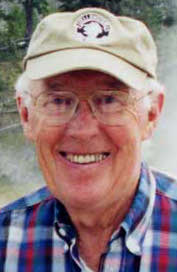Thomas D. Brock | |
|---|---|
 July 2002, Yellowstone Park | |
| Born | September 10, 1926 Cleveland, Ohio, U.S. |
| Died | April 4, 2021 (aged 94) Madison, Wisconsin, U.S. |
| Alma mater | Ohio State University |
| Known for | Thermophilic bacteria Thermus aquaticus |
| Awards | Golden Goose Award (2013) |
| Scientific career | |
| Fields | Microbiology |
| Institutions | The Upjohn Company Case Western Reserve University Indiana University University of Wisconsin–Madison |
| Thesis | Studies on the metabolism of the yeast, Hansenula anomala (Hansen) Sydow (1952) |
| Doctoral advisor | William D. Gray |
Thomas Dale Brock (September 10, 1926 – April 4, 2021) was an American microbiologist known for his discovery of hyperthermophiles living in hot springs at Yellowstone National Park. In the late 1960s, Brock discovered high-temperature bacteria living in the Great Fountain region of Yellowstone, and with his colleague Hudson Freeze, they isolated a sample which they named Thermus aquaticus.[1] "Life at High Temperatures", a 1967 article summarizing his research, was published in the journal Science and led to the study of extremophiles, organisms that live in extreme environments. By 1976, T. aquaticus was found useful for artificially amplifying DNA segments. Brock's discoveries led to great progress in biology, contributed to new developments in medicine and agriculture, and helped create the new field of biotechnology.[2]
- ^ Brock, Thomas D. (March 1998). "Early Days in Yellowstone Microbiology" (PDF). ASM News. 64 (3). American Society for Microbiology: 137–140. Archived from the original (PDF) on March 4, 2016. Retrieved February 3, 2015.
- ^ Snyder, Brian (October 2007). "Why the NSF Biology Budget Should Be Doubled". BioScience. 57 (9). American Institute of Biological Sciences: 727–728. doi:10.1641/B570902. ISSN 0006-3568.